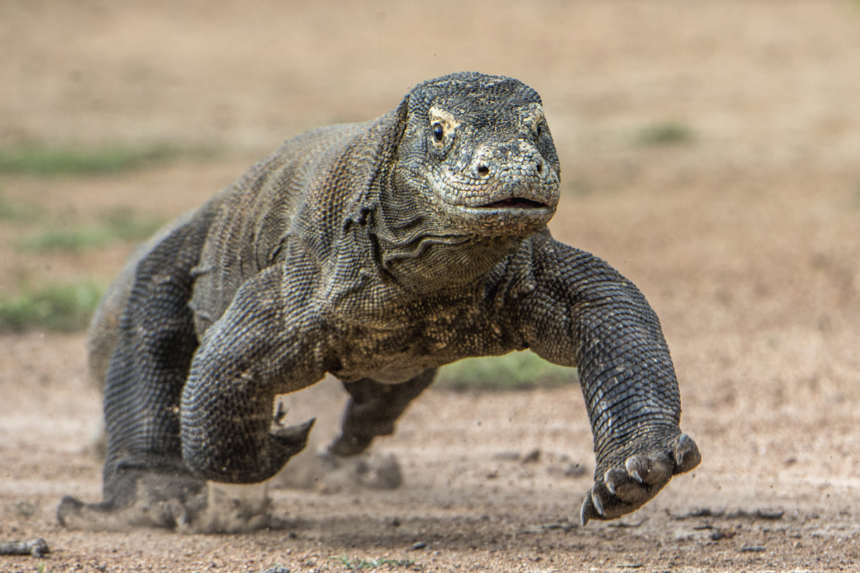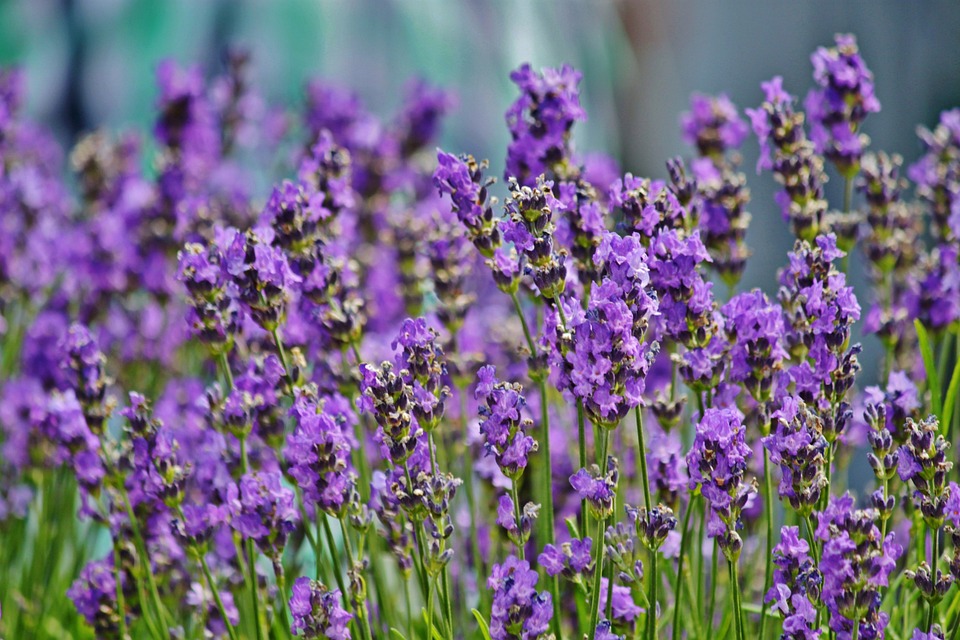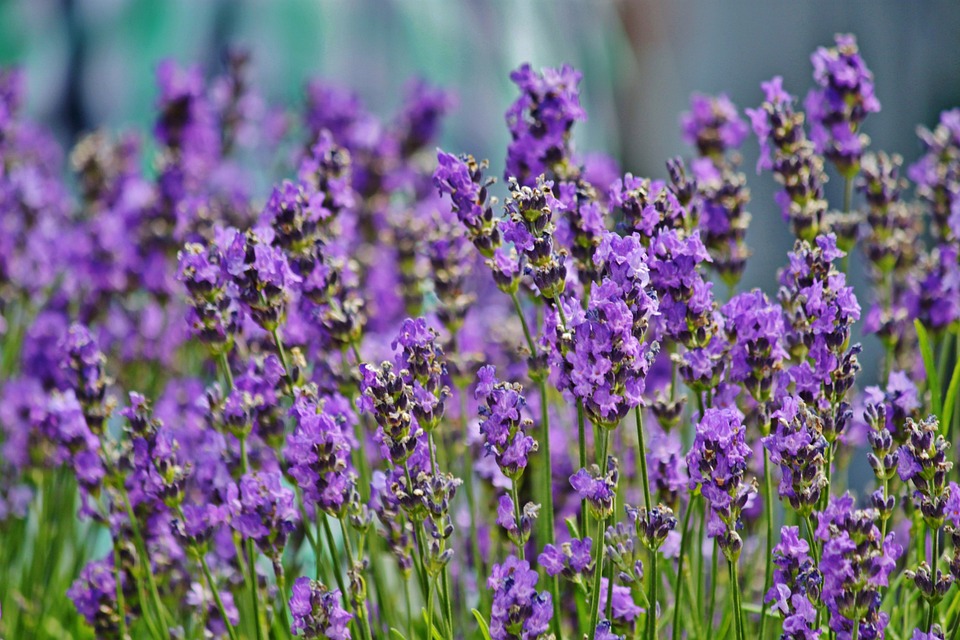In the remote and rugged islands of Indonesia, an apex predator reigns supreme, blending ancient predatory prowess with a suite of modern adaptations that make it one of the most formidable hunters on Earth.
The Komodo dragon (Varanus komodoensis), the world’s largest living lizard, is a master of its environment, utilizing a combination of stealth, strength, and venom to subdue prey.
This article explores the intricate hunting strategies of Komodo dragons, delving into their physiology, behavior, ecological role, and the evolutionary adaptations that have cemented their status as top-tier predators.
I. Introduction: The Apex Predator of the Indonesian Archipelago

The Komodo dragon, found primarily on the islands of Komodo, Rinca, Flores, Gili Motang, and Gili Dasami, is an evolutionary marvel.
These reptiles can grow up to 10 feet in length and weigh as much as 150 pounds, making them the largest lizards in the world.
Their hunting strategies are a blend of ancient instincts and modern adaptations, allowing them to dominate their habitats.
II. Anatomy of a Predator: Physical Adaptations for Hunting
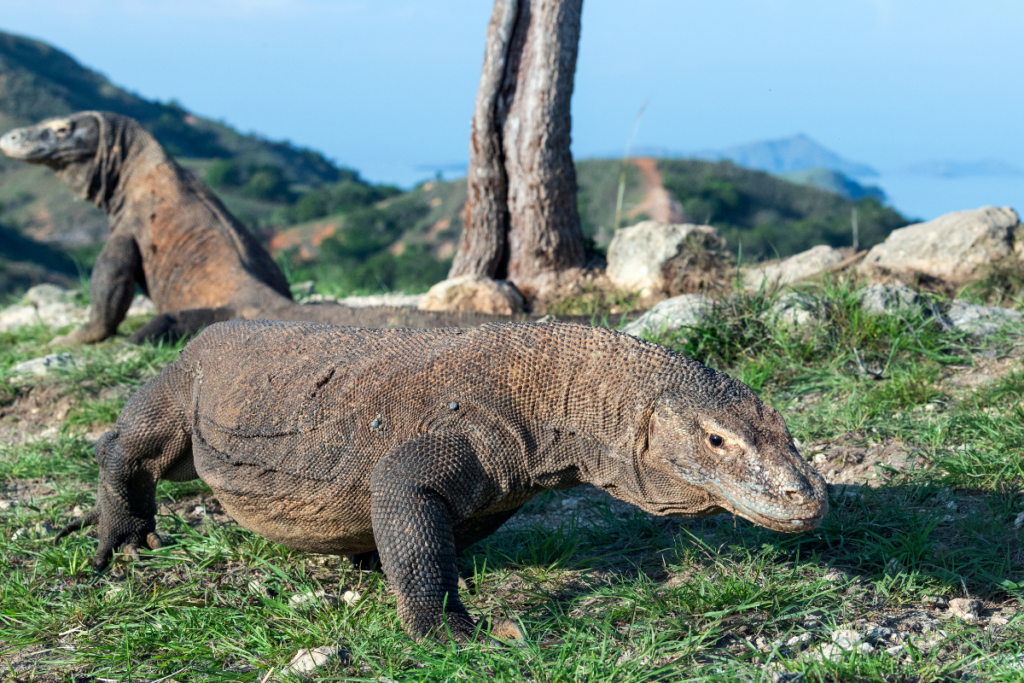
A. Size and Strength
Komodo dragons are built for power.
Their muscular bodies and strong limbs enable them to tackle large prey, such as deer and wild boar.
The dragon’s sheer size intimidates potential competitors and prey alike, establishing its dominance within its ecosystem.
B. Sensory Adaptations
Keen Sense of Smell: Komodo dragons possess an acute sense of smell, primarily facilitated by their forked tongues and Jacobson’s organ.
By flicking their tongues, they can “taste” the air and detect chemical cues from potential prey up to several kilometers away.
Sharp Vision: Their vision is well-suited for detecting movement, essential for identifying prey from a distance.
While their eyesight is not as sharp as that of some birds of prey, it is highly effective for their predatory needs.
Hearing: Although not their primary sense, Komodo dragons have good hearing, allowing them to detect the sounds of potential prey or threats.
III. Hunting Techniques: The Art of Ambush and Stealth
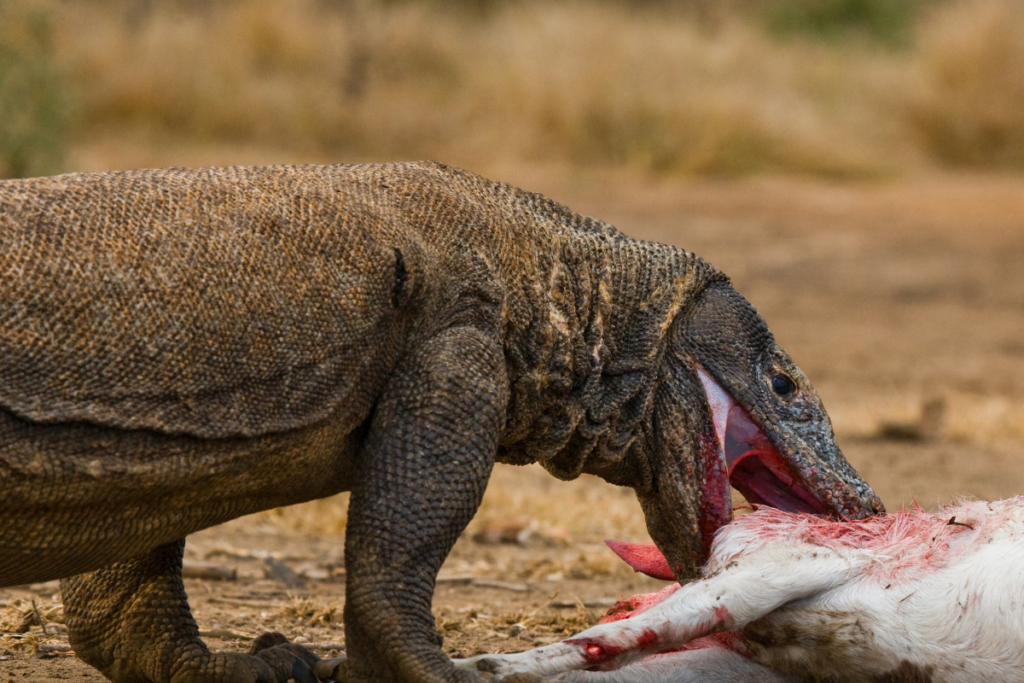
A. Ambush Predation
Komodo dragons are ambush predators, relying on patience and stealth.
They often lie in wait along well-trodden animal paths, remaining motionless for hours until an unsuspecting prey comes within striking distance.
Their camouflage helps them blend into their surroundings, enhancing their ability to surprise their prey.
B. Pursuit and Attack
Once a Komodo dragon identifies its target, it can burst into action with surprising speed and agility.
They can sprint at speeds of up to 13 miles per hour for short distances, closing the gap quickly to deliver a lethal bite.
Their strong jaws and sharp teeth are designed to grip and tear flesh, ensuring that the initial attack is often fatal or debilitating.
IV. The Venomous Edge: Biochemical Warfare
A. Venom Composition
Unlike most lizards, Komodo dragons possess venom glands located in their lower jaws.
The venom contains a mix of toxic proteins, including anticoagulants, which prevent blood clotting, and hypotensive agents, which lower blood pressure.
These components work together to induce shock and rapid blood loss in the prey.
B. Delivery Mechanism
The venom is delivered through multiple ducts in their gums as they bite.
The serrated teeth create deep wounds, ensuring that the venom penetrates the tissues effectively.
This venomous bite weakens the prey, making it easier for the dragon to overpower even large animals.
V. Feeding Strategies: From Bite to Feast
A. Stalking and Wounding
Komodo dragons may bite their prey and then follow it, allowing the venom and resulting infection to incapacitate the animal over time.
This strategy minimizes the risk of injury to the dragon and ensures that the prey is weakened before the final confrontation.
B. Scavenging Behavior
Komodo dragons are opportunistic feeders and will scavenge on carrion.
Their keen sense of smell enables them to locate carcasses from great distances.
This scavenging behavior plays a vital role in their ecosystem, helping to clean up dead animals and prevent the spread of disease.
C. Feeding Frenzy
Once the prey is down, Komodo dragons engage in a feeding frenzy.
Their powerful jaws and sharp teeth allow them to consume large chunks of flesh quickly.
They have a highly elastic stomach, enabling them to eat up to 80% of their body weight in a single meal.
Their slow metabolism allows them to survive on this feast for weeks before needing to hunt again.
VI. Ecological Role: Balancing the Ecosystem
A. Apex Predator Dynamics
As apex predators, Komodo dragons regulate the populations of their prey, maintaining a balance within their ecosystem.
This top-down control is crucial for preventing overgrazing and ensuring biodiversity.
B. Impact on Prey Species
The presence of Komodo dragons influences the behavior and population dynamics of prey species.
Prey animals develop strategies to avoid predation, such as altering their feeding patterns and seeking safer habitats.
This predator-prey interaction drives evolutionary adaptations in both the predator and prey.
VII. Reproduction and Territoriality: Ensuring Survival
A. Mating Behavior
Komodo dragons are solitary animals, coming together only during the breeding season.
Males engage in fierce combat to win the right to mate with females.
These battles can be brutal, with the victor earning the right to reproduce and pass on its genes.
B. Nesting and Offspring
Females lay their eggs in burrows or abandoned nests, guarding them until they hatch.
The young dragons are vulnerable to predation, including from other Komodo dragons, and often take to the trees for safety.
This arboreal phase helps them avoid ground-based threats until they are large enough to defend themselves.
VIII. Conservation Challenges: Protecting a Predator
A. Habitat Loss
The primary threat to Komodo dragons is habitat loss due to human activities such as deforestation, agricultural expansion, and development.
As their natural habitats shrink, the dragons face increased competition for resources and potential conflicts with humans.
B. Climate Change
Climate change poses a significant threat to Komodo dragons by altering their habitat and affecting prey availability.
Rising temperatures and changing rainfall patterns can disrupt the delicate balance of their ecosystem.
C. Conservation Efforts
Efforts to protect Komodo dragons focus on habitat preservation, anti-poaching measures, and community engagement.
Komodo National Park plays a crucial role in providing a sanctuary for these predators.
Conservation programs also include research initiatives to better understand their behavior, genetics, and ecological needs.
IX. Human-Dragon Interactions: Coexistence and Conflict
A. Cultural Significance
Komodo dragons hold a place of reverence and fear in local cultures.
They are often featured in myths and folklore, symbolizing strength and mystery.
Understanding and respecting these cultural connections is important for effective conservation efforts.
B. Tourism and Conservation
Tourism in Komodo National Park provides economic benefits but also poses challenges for conservation.
Managing human-dragon interactions is crucial to prevent habitat degradation and ensure the safety of both visitors and dragons.
Sustainable tourism practices and education programs are key to balancing conservation with tourism.
X. The Future of Komodo Dragons: Challenges and Opportunities
A. Research and Monitoring
Ongoing research and monitoring are essential for understanding the changing dynamics of Komodo dragon populations.
Advances in technology, such as GPS tracking and genetic analysis, provide new insights into their behavior and ecology.
B. Community Involvement
Engaging local communities in conservation efforts is critical.
Programs that promote sustainable livelihoods and raise awareness about the importance of protecting Komodo dragons can foster a sense of stewardship and reduce human-wildlife conflict.
C. Global Conservation Strategies
Collaborative efforts at the national and international levels are necessary to address the broader threats to Komodo dragons, such as climate change.
Conservation organizations, governments, and local communities must work together to develop and implement effective strategies.
XI. Conclusion: Legacy of a Predator
The Komodo dragon, with its blend of ancient instincts and modern adaptations, represents a living link to the past and a vital part of its ecosystem.
Understanding and appreciating the complex hunting strategies and ecological role of these predators is essential for their conservation.
As we continue to unravel the mysteries of Komodo dragons, we gain not only insights into their world but also a deeper appreciation for the delicate balance of nature.
Ensuring the survival of Komodo dragons requires a multifaceted approach, combining scientific research, habitat protection, community engagement, and sustainable tourism practices.
By protecting these magnificent reptiles, we preserve a unique piece of our natural heritage and contribute to the health and diversity of our planet’s ecosystems.
In essence, the story of the Komodo dragon is one of venom and victory, a testament to the enduring power of nature’s ancient predators and the ongoing efforts to ensure their place in the modern world.

